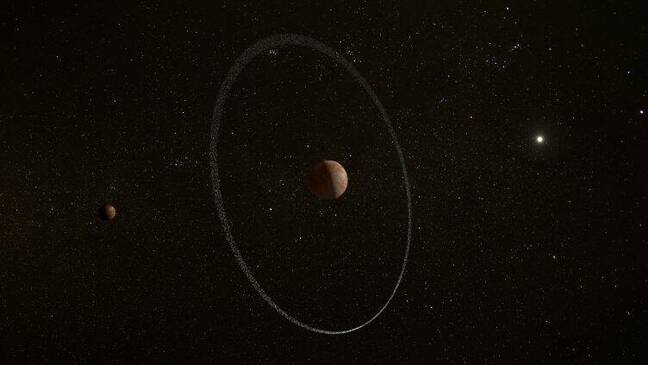This article is more than 1 year old
Ring system discovered around dwarf planet Quaoar leaves astronomers puzzled
Structure appears to be so far out, the Roche limit may need revising
A ring system has been spotted around dwarf planet Quaoar at a distance astronomers didn't believe was possible, defying astronomical theories on how these structures form.
Quaoar lies in the Kuiper belt beyond Neptune. The icy rock is 1,121 kilometers (697 miles) wide, about half the diameter of Pluto. Quaoar is a distant object with interesting properties, including signs it may harbor ice-spewing volcanoes and a ring system.
Debris compressed into rings orbiting planets are found around the gas giants Saturn, Jupiter, Uranus and Neptune, and dwarf planets Chariklo and Haumea. All the ring systems lie relatively close to their host planets within a distance known as the Roche limit.
The Roche limit states that ring systems can only form within a distance where the tidal forces from a larger body are more powerful than a smaller object's own gravitational forces. In short, debris captured inside a planet's Roche limit will be ripped apart and compressed into a ring system. Any material outside this distance, however, will more likely stick together under gravity and form a moon instead.
Quaoar, however, breaks this rule. Its ring system is intact at orbits at a distance over seven times the dwarf planet's radius. Saturn's ring system is located at a distance only three times its radius, for comparison. Now astronomers are puzzled over how such a ring system can survive so far from its parent body.
"It was unexpected to discover this new ring system in our Solar System, and it was doubly unexpected to find the rings so far out from Quaoar, challenging our previous notions of how such rings form," said Vik Dhillon, co-author of the research published in Nature and a physics and astronomy professor from the University of Sheffield.
- Truck-size asteroid makes one of the tightest fly-bys of Earth ever recorded
- The years fly by on first exoplanet confirmed by James Webb Space Telescope
- Literally, look who's back: A comet that last swung by Earth 50,000 years ago
- Peekaboo: Once-hidden galaxy revealed to be window into cosmic history
A team of researchers observed Quaoar over 2018 to 2021 using ground-based telescopes and ESA's CHEOPS spacecraft. Data measuring the dimming of background stars as the dwarf planet passed in front of them showed two dips, suggesting there is something else around the object blocking sunlight.
Bruno Morgado, lead author of the paper and a researcher from the Universidade Federal do Rio de Janeiro, Brazil, combined different sources of data taken from other observatories and by citizen scientists to figure out what might be lurking around Quaoar. The ring system is too small and faint to directly image.
"When we put everything together, we saw drops in brightness that were not caused by Quaoar, but that pointed to the presence of material in a circular orbit around it. The moment we saw that we said, 'Okay, we are seeing a ring around Quaoar,'" he said in a statement.
Astronomers are now puzzled at how such a ring system can survive so far from its parent planet.
"What is so intriguing about this discovery around Quaoar is that the ring of material is much farther out than the Roche limit. As a result of our observations, the classical notion that dense rings survive only inside the Roche limit of a planetary body must be thoroughly revised," Giovanni Bruno, co-author of the paper and a researcher at the INAF's Astrophysical Observatory of Catania, Italy, added.
The Register has asked the researchers for comment. ®

